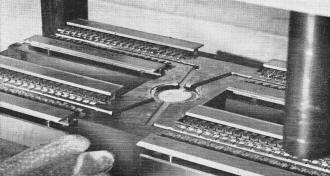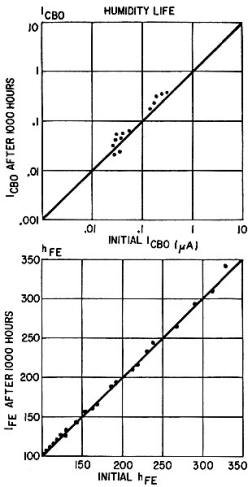|
March 1967 Radio-Electronics
 [Table of Contents] [Table of Contents]
Wax nostalgic about and learn from the history of early electronics.
See articles from Radio-Electronics,
published 1930-1988. All copyrights hereby acknowledged.
|
Have you ever heard of a
"Joy bomb" in regard to encapsulation of semiconductors in plastic packages? It
took me a moment to figure out what the author was referring to when I read it
in this 1967 Radio-Electronics magazine article entitled "Plastic Transistors - The Future Billions."
Joy was (is) a household dishwashing
detergent that has been around since 1949. I still remember the corny "Lemon
Joy" commercials from the 1970s with people being utterly overcome with the joy
of seeing their reflections in the dishes cleaned in Joy... but I digress.
Although not explicitly mentioned, I assume a concentrated liquid soap was used because, as when pouring soap on a tire when looking for an air leak, a
visible bubble will form at the site of the breach. That was part of the initial
investigation into using plastic. We take for granted cheap
plastic packaging, but the transition from bulky, heavy, hollow metal cans which
were vulnerable to vibration, to small. lightweight, fully encapsulated packages
that capture the wirebond connections greatly improved affordability and
reliability.
Plastic Transistors - The Future Billions

This mold is used for compressing the transistor into a rock-hard plastic capsule.
The newest type of solid-state package.
By Keith W. Bose
The growth of solid-state technology from the early days of germanium to the
silicon field-effect transistor has been marked by lulls and spurts of activity.
Now there is another surge of action caused by the introduction of a line of low-cost
solid-state devices with plastic encapsulation. The use of plastic makes possible
a dramatic price drop in transistors, thus opening new areas to electronics. Industry
leaders are saying that by 1971 the world will use close to two billion plastic-encapsulated
semiconductors.
A silicon field-effect transistor with a retail price of only a dollar is some-thing
to think about! The availability of such a low-cost device means more electronic
applications in the automotive field. Safety devices and driving aids are simpler
to manufacture, for instance.
The immediate use for plastic transistors, however, is probably in hi-fi, TV
and electronic organs. One amplifier manufacturer reduced his selling price by two-thirds
and found that his sales quadrupled. Even the voracious appetite of computers for
solid-state devices is being satisfied with the technique of plastic encapsulation.
Plastics engineers climbed a long hill before airtight plastic packages became
a reality. After 3 years of experience with the technique, engineer George Berryman
of Texas Instruments says that "we have found plastic units as reliable as their
counterparts in metal cans."
The plastics involved are derivatives of epoxy, that familiar hardware-store
glue that provides rock-hard bonding between almost any two substances.
The big problem in transistor manufacture was getting a package that could completely
seal off air. This sounds easy, but for chemical reasons it's difficult to form
a tight bond between plastic and metal. This bond is necessary where the transistor
leads enter the case. It is often said that the semiconductor art has two phases-growing
the chip, then packaging it so it will operate. Some solid-state manufacturers send
chips overseas, there to be packaged in areas of low-cost labor and then return
to the U.S.

The effect of humidity on ICBO and hFE in a group of plastic
transistors. Straight-line before-and-after plots show stability.
Plastic-encapsulated semiconductors are manufactured by either of two processes:
the liquid or cast-molding system, or the transfer-molding system. The liquid system
uses a "header" of ceramic and plastic to hold the leads. This header is formed
from powdered glass and ceramic which is first compressed. A charge of ceramic powder
follows a charge of glass, followed by a charge of ceramic in a press die. The powder
is then compressed until the chemical binder sticks the whole mass together in a
solid form.
The presses used for liquid or cast molding are multiple rotary affairs. The
forms are "fired" after lead insertion to form a solid mass. The header, together
with the leads fused to it and with the chip connected, is covered with liquid plastic,
usually in a mold, then baked. The process is messy. Because the resin must be mixed
with a hardener just before use, only small batches at a time are mixed, and proportions
are carefully controlled.
Transfer molding is initially more expensive process, but for volume production
it offers more advantages. The process uses a dry-mix compound which is transferred
to a hot die by heat and pressure. In the process the mixture goes from a solid
to a liquid and then back to a solid state. When finished, the chip is surrounded
with only one substance - the plastic - and the leads and bonding wires are embedded
to form a highly reliable unit.
When a completely new product is developed, some assurance of its reliability
must be established. One way to check reliability is simply to sell the product
and wait for the customers to scream. This is certainly no way to keep customers
or to introduce new products. The safe method is a laboratory test program. Plastic
semiconductors have been heated, cooled, pounded, dropped, and given all sorts of
rough treatment. Areas of reliability testing are resistance to moisture and the
ability to withstand thermal and physical shock. One other consideration is possible
damage to the chip by the plastic itself.
Moisture resistance is tested by using what's called a "Joy bomb." A semiconductor
is sealed into the "bomb" along with detergent solution. Hydrostatic pressure then
forces moisture through any leaks. The new plastics pass this test with flying colors.
Humidity resistance is tested in a "bowser box" - a test chamber in which temperature,
humidity and pressure may be precisely controlled. A common ritual for semiconductor
testing is 1,000 hours or longer at 90% relative humidity and +45°C.
In many circuits it is important for a transistor to maintain its parameters
within certain limits over long periods of operation. The graphs show a "scatter"
plot of ICBO and hFE for one transistor after 1,000 hours
of back bias at elevated temperatures and high humidity. The 45° lines represent
no change from initial readings. Note the close grouping around this line, showing
excellent stability. One company - Texas Instruments - has gathered reliability
data from 2 million hours of test operation. It appears that plastic semiconductors
are here to stay and, what's more important, at low prices.
As an example of the low cost of plastic transistors, the small-quantity retail
price of the 2N4419 is in the neighborhood of 50¢. This device is one of a
line of npn/pnp high-speed low-level switches.
Another good example, now available in quantities of 1-99 at $1.50 each, is the
TIP24. Just for comparison, when silicon transistors were first made, around 1960,
they sold for $15 or more.
The TIP24 is a 2-amp epitaxial-planar silicon power transistor. It could be a
boon for audio. A pair of TIP24's will easily deliver 20 watts. The devices will
sell in pairs matched within 20% (IC = 1.5 amp) assuring minimum distortion
in class-B operation. A mounting tab serves as the collector lead of this double-ended
low-profile package. This feature allows mounting with only one chassis hole and
a sheet-metal screw. In production, it is possible to form the leads and tab for
special mounting requirements. Good beta linearity and low saturation voltage is
claimed for this transistor, when operated on a 70-volt supply and delivering 10
watts, with 167°F case temperature. With both high voltage and high current,
good speaker matching is claimed.
Another low-cost transistor, usable as an oscillator, a multivibrator, a wave-form
generator or an SCR trigger, is the TIS43. This one will withstand an acceleration
of 60,000 times the force of gravity!
Both silicon and germanium transistors are being encapsulated in plastic. Silicon
types are valuable because of their reliability. Their high-temperature characteristics
are valuable in places like auto radios and solid-state ignition systems where temperatures
soar on hot summer days. Germanium can still turn in the best record for performance,
however, and for lowest cost it is still the leader.
Plastic economy packages are available in both silicon and germanium transistors,
field-effect transistors, unijunction transistors, power transistors, silicon rectifiers
and integrated circuits. Plastic transistors can be mounted flush on PC boards,
reducing the possibility of shorts from excess solder and other production mistakes.
One-piece construction leads to increased reliability.
A new plastic IC family of 11 digital circuits (designated 15830N) includes multiple
gates, buffers, expanders, binary elements and a one-shot multivibrator. Plastic
encapsulation reduces the price of these circuits 25%. Shock and vibration resistance
and heat dissipation of these plastic IC's are excellent. The leads are in two rows,
spaced 0.3-inch apart and the units are designed for high-speed automatic insertion
in PC boards or chassis.
In production quantities the TIXM-12 costs only $1. This is a germanium planar
field-effect transistor for vhf mixers and amplifiers. It has low cross-modulation
distortion, with a noise factor of 2 dB at 10 MHz.
National Electronics, Inc. (a subsidiary of Varian) is now producing a new low-cost
readout driver using plastic transistors. Because the price has been reduced, many
industrial users will now be able to use readouts on their production lines. Formerly
such devices were considered luxuries by many small industrial plants.
Engineers are saying that there are exciting possibilities in low-cost field-effect
transistors. The FET has, of course, a number of advantages over both vacuum tubes
and junction transistors. It's high impedance makes it useful in many circuits where
ordinary low-Z transistors couldn't be used. Furthermore, the output impedances
of the source and drain circuits are roughly the same, which is not true of tube
plate and cathode circuits.
Plastic encapsulation of FET's increases their reliability and lowers their cost.
These are two reasons for predicting that FET's will be used more and more in the
next few years. Epoxy capsules seem a major step forward in solid-state technology.
Posted October 30, 2023
|








